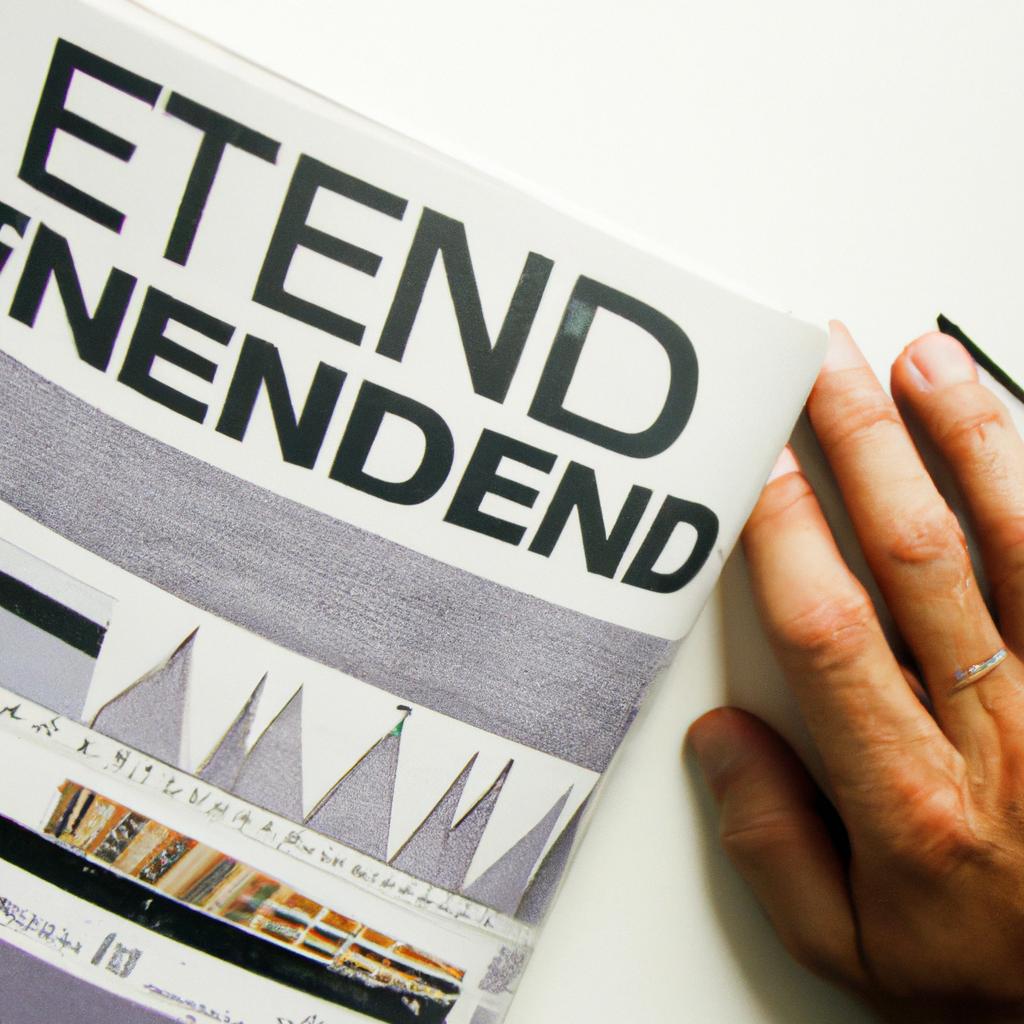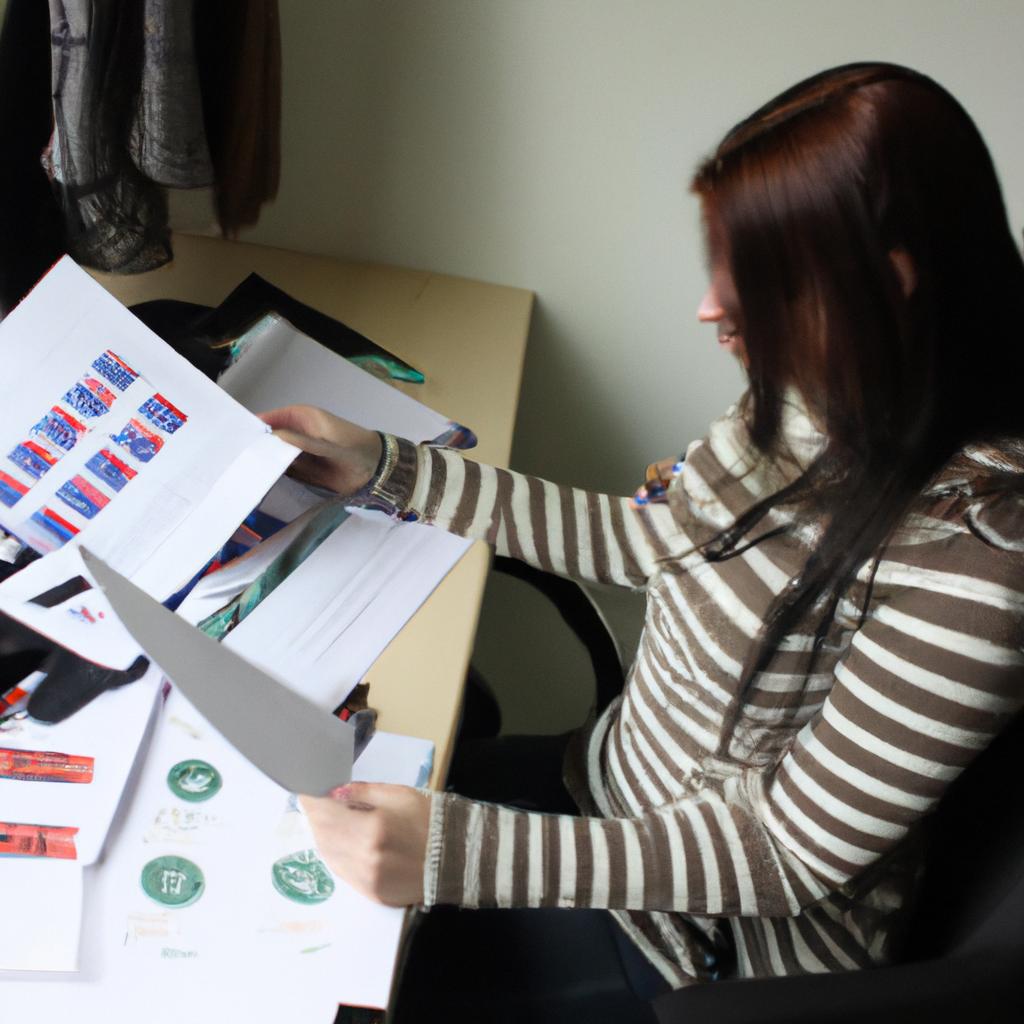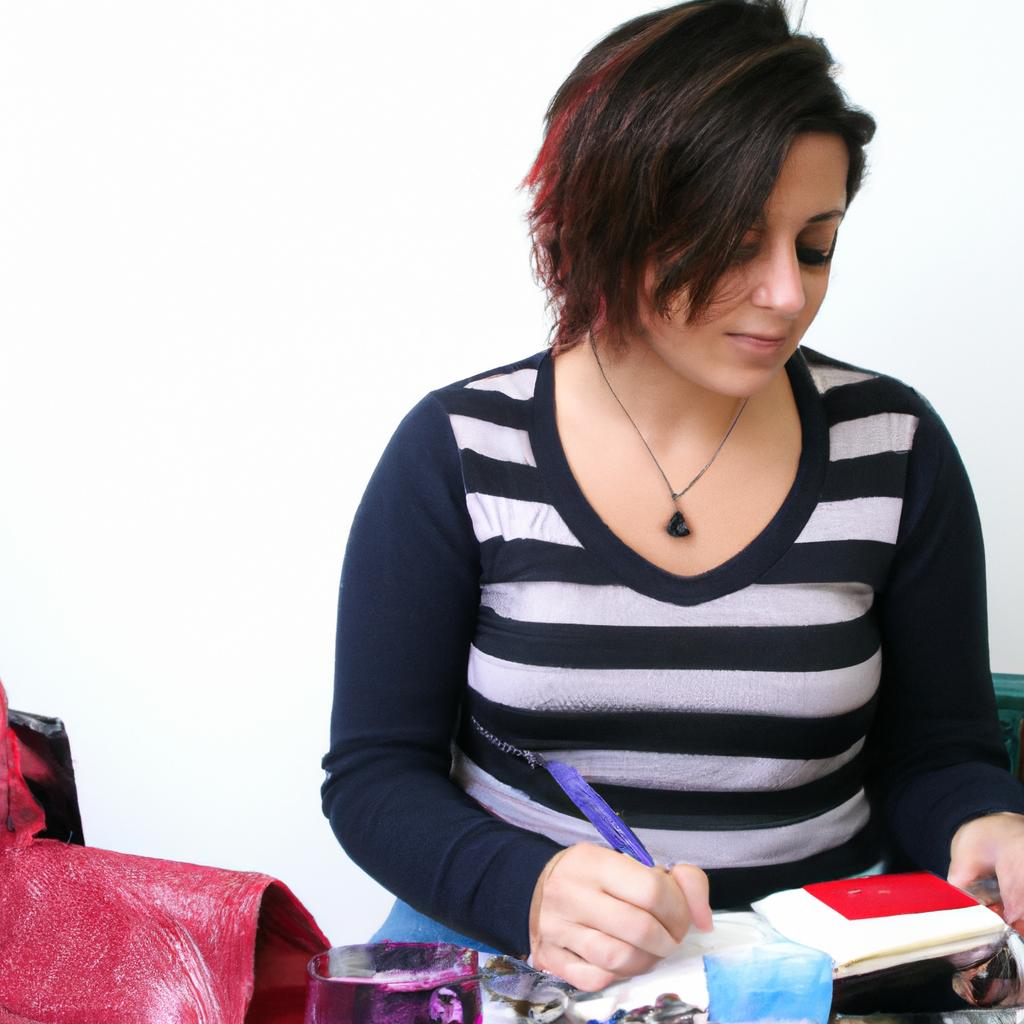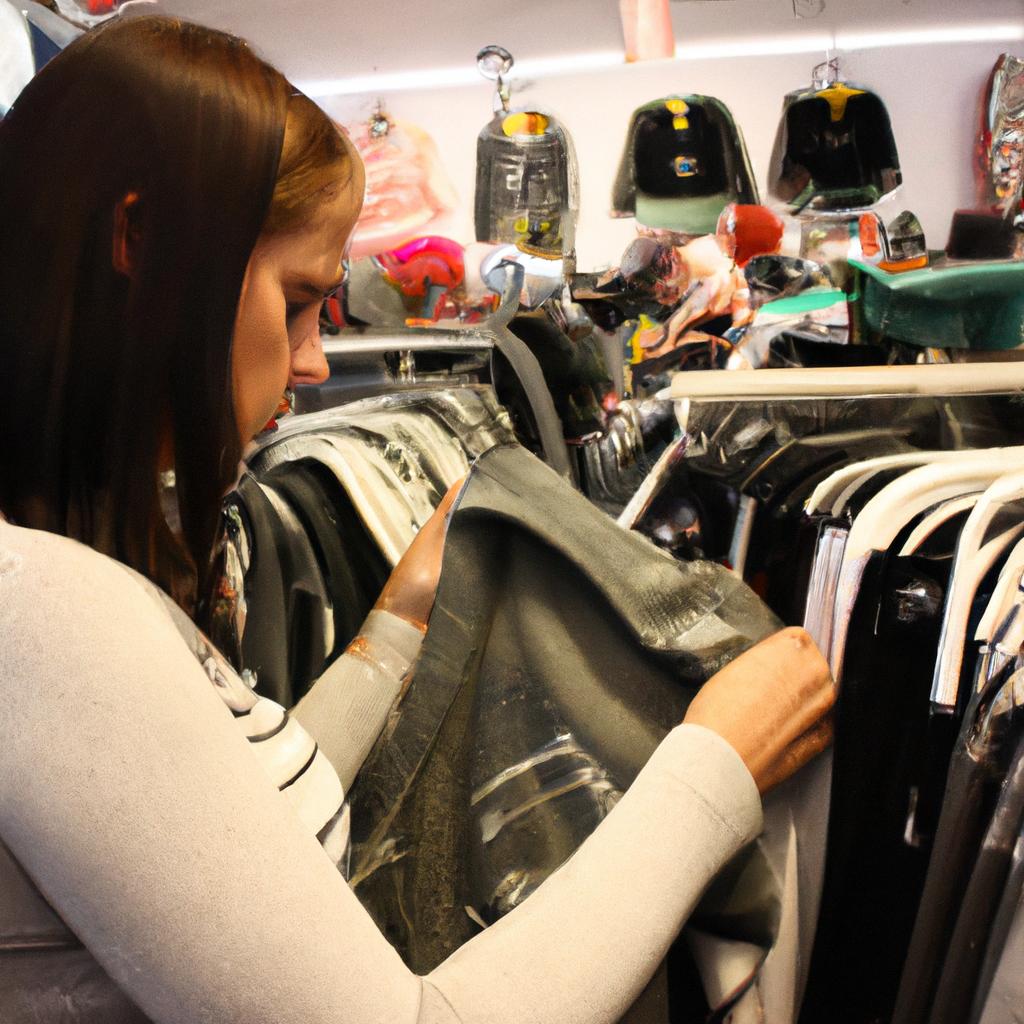Wardrobe Essentials: Women’s Fashion Finance Guideline
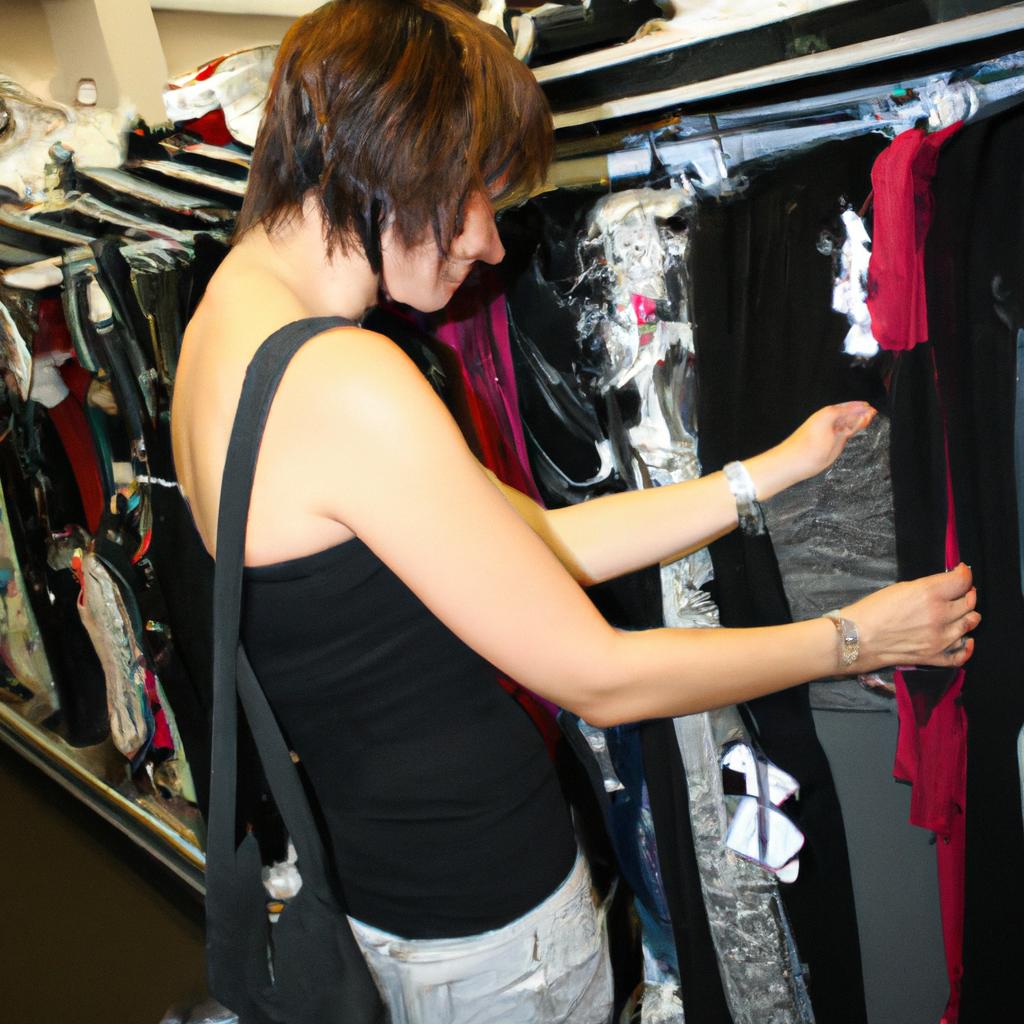
In today’s fast-paced and ever-evolving world of fashion, staying on top of the latest trends can be a costly endeavor. With new styles constantly emerging and changing seasons dictating wardrobe updates, it is easy for women to find themselves overwhelmed by financial strain in pursuit of maintaining a fashionable image. This article aims to provide a comprehensive guideline on wardrobe essentials for women, with a focus on managing fashion expenses effectively.
Consider this hypothetical scenario: Sarah, an aspiring professional in her late twenties, finds herself struggling to strike a balance between dressing stylishly and adhering to a tight budget. Like many other women, she wants to create a versatile and timeless wardrobe that reflects her personal style while being mindful of her finances. In such situations, having a well-thought-out fashion finance plan becomes crucial. By understanding the importance of essential pieces and strategically investing in high-quality items, Sarah can build a functional wardrobe without compromising her financial stability.
With this example in mind, this article will delve into various key aspects of building a cost-effective yet fashionable wardrobe for women. From identifying essential garments that serve as the foundation of any outfit to exploring smart shopping strategies and tips for maximizing budgetary resources, we will equip readers with valuable insights to navigate the complex realm of women’s fashion with financial savvy.
-
Identifying Essential Garments: The first step in creating a cost-effective wardrobe is to identify the essential garments that serve as the building blocks of any outfit. These include versatile pieces such as a little black dress, tailored trousers, a white button-down shirt, a well-fitting blazer, and comfortable yet stylish shoes. By investing in high-quality versions of these timeless classics, Sarah can mix and match them with other more trend-driven items to create countless outfits without breaking the bank.
-
Smart Shopping Strategies: When it comes to shopping for fashion on a budget, being strategic is key. Sarah can start by setting a realistic budget for her clothing expenses and sticking to it. She can also make use of sales, discounts, and promotional offers to maximize her purchasing power. Additionally, exploring thrift stores, consignment shops, and online platforms for pre-loved or vintage items can unearth hidden gems at affordable prices. Lastly, subscribing to newsletters or following brands on social media will keep her updated on upcoming sales events and exclusive discounts.
-
Quality Over Quantity: Investing in high-quality garments may seem counterintuitive when trying to save money initially but proves beneficial in the long run. Quality pieces tend to last longer and withstand regular wear and tear better than their cheaper counterparts. By focusing on durability rather than fleeting trends, Sarah can build a wardrobe that stands the test of time without having to constantly replace worn-out items.
-
Mix-and-Match Approach: Another effective way for Sarah to maximize her wardrobe while keeping costs low is through a mix-and-match approach. By selecting items that are easily coordinated with each other, she can create multiple outfits from just a few key pieces. For example, pairing a blazer with jeans for a casual look or dressing it up with tailored trousers for work allows for versatility without the need for excessive spending.
-
Renting or Borrowing: For special occasions or one-time events, Sarah can consider renting clothing or accessories instead of purchasing them outright. Numerous online platforms offer rental services for designer dresses, handbags, and jewelry at a fraction of the retail price. This allows her to wear something special without the commitment of owning it permanently.
-
Wardrobe Maintenance: Taking proper care of her garments is essential in prolonging their lifespan and reducing the need for replacements. Following care instructions on garment labels, storing items correctly, and promptly addressing any repairs or alterations will help Sarah maintain the quality and appearance of her wardrobe investment.
By implementing these strategies and being mindful of her fashion expenses, Sarah can build a cost-effective yet fashionable wardrobe that aligns with her personal style and financial goals. It’s all about finding a balance between staying on-trend and smartly managing resources without sacrificing quality or breaking the bank. With careful planning and consideration, she can navigate the world of women’s fashion with confidence and financial savvy.
Understanding Your Budget
Imagine you walk into your favorite clothing store and spot a gorgeous designer dress. The price tag reads $500, and it’s tempting to splurge on such a luxurious item. However, before making any impulsive purchases, it is crucial to have a clear understanding of your budget. By establishing a budget for your wardrobe expenses, you can make informed decisions about which fashion items are worth investing in.
To begin with, consider evaluating your current financial situation. Take into account factors such as income, monthly expenses, and savings goals. This assessment will help you determine how much disposable income you have available to allocate towards clothing purchases. It may be helpful to create a detailed spreadsheet or use personal finance apps that track your spending habits.
Once you have determined the amount of money you can comfortably allocate towards your wardrobe, it is essential to prioritize your fashion needs accordingly. Consider creating a hierarchy of importance when it comes to purchasing new clothing items. For example:
- Basic essentials: These include versatile pieces like plain t-shirts, jeans, and black pants that form the foundation of any outfit.
- Statement pieces: These are trendy or unique items that add personality and style to your wardrobe.
- Workwear attire: If you have specific professional requirements or attend formal events regularly, allocating funds towards work-appropriate clothing should be prioritized.
- Seasonal updates: As seasons change, certain items become more necessary than others (e.g., coats in winter or swimsuits in summer).
By categorizing your fashion needs based on priority level, you can ensure that your budget aligns with both practicality and personal style preferences.
As an additional tool for visualizing your budget allocation effectively, refer to the following table:
| Category | Allocation % |
|---|---|
| Basic essentials | 40% |
| Statement pieces | 30% |
| Workwear attire | 20% |
| Seasonal updates | 10% |
This table serves as a guide to help you distribute your budget across different fashion categories. However, it is important to note that these percentages can be adjusted according to individual preferences and circumstances.
In summary, understanding your budget is the first step towards making informed decisions about your wardrobe expenses. By evaluating your financial situation, prioritizing fashion needs, and allocating funds accordingly, you can ensure efficient and responsible spending habits. With this foundation in place, let’s explore how investing in versatile pieces will enhance the longevity of your wardrobe.
Transitioning into the subsequent section on “Investing in Versatile Pieces,” we delve deeper into strategies for building a timeless and functional wardrobe without breaking the bank.
Investing in Versatile Pieces
Imagine this scenario: Sarah, a working professional, has a limited budget for her wardrobe but wants to look stylish and put-together every day. She realizes that investing in versatile pieces is the key to maximizing her wardrobe options without breaking the bank. By carefully selecting items that can be mixed and matched, she can create numerous outfits for various occasions.
To achieve this goal, there are several factors to consider:
-
Color Palette:
- Opt for neutral colors such as black, white, gray, navy blue, or beige.
- These timeless shades form the foundation of any outfit and can easily be paired together or accessorized with bolder hues.
-
Classic Silhouettes:
- Choose clothing items with classic silhouettes that never go out of style.
- A well-tailored blazer, tailored trousers or skirts, button-down shirts, and simple dresses are all great examples.
-
Layering Pieces:
- Invest in layering pieces like cardigans, vests, or lightweight jackets.
- These items allow you to transform your outfits from casual to more formal or adapt them according to changing weather conditions.
-
Accessories:
- Enhance your looks with accessories like scarves, belts, statement jewelry, or handbags.
- They can instantly elevate even the simplest outfits and add personal flair.
By following these guidelines and incorporating mix-and-match options into your wardrobe choices, you’ll have endless possibilities when it comes to creating different ensembles suitable for any occasion. The table below showcases how just a few key items can be combined to produce varied outfits:
| Outfit Combination | Components |
|---|---|
| Professional Look | Tailored Blazer + Trousers |
| Casual Chic | Button-down Shirt + Jeans |
| Office Appropriate | Simple Dress + Cardigan |
| Versatile Ensemble | Layered Vest + Skirt |
Transitioning into the subsequent section, it becomes apparent that quality should always take precedence over quantity when building a versatile wardrobe. By focusing on investing in key pieces and understanding their long-term value, you can create an enduring collection of clothing that will serve you well for years to come.
Quality Over Quantity
Building a wardrobe filled with versatile pieces is essential for any woman who wants to make the most of her fashion budget. By investing in items that can be styled in multiple ways, you not only maximize your outfit options but also ensure long-term value for your money. Take Sarah, for example – she purchased a classic black blazer that could be worn to work, dressed up for an evening event, or paired with jeans for a casual outing. This one piece alone gave her countless outfit possibilities without breaking the bank.
To guide you further on investing in versatile pieces, here are four key factors to consider:
-
Timeless Style: Opt for items that have timeless appeal rather than following fleeting trends. Classic silhouettes and neutral colors tend to stand the test of time and can easily be incorporated into various outfits.
-
Multi-Seasonal Use: Look for pieces that can be worn across different seasons by layering or accessorizing accordingly. For instance, a lightweight cardigan can serve as both outerwear during spring and summer evenings and as an additional layer under coats during colder months.
-
Mix-and-Match Potential: Choose items that can seamlessly mix and match with other garments in your wardrobe. A versatile blouse that pairs well with skirts, pants, and even shorts will open up numerous styling options.
-
Quality Construction: Invest in high-quality fabrics and craftsmanship when purchasing versatile pieces. Well-made clothing lasts longer and retains its shape better over time, ensuring durability and continued wearability.
Table: Benefits of Investing in Versatile Pieces
| Benefit | Explanation |
|---|---|
| Cost-effective | Spending more initially on quality staples saves money in the long run as they withstand repeated use without wearing out quickly or going out of style too soon. |
| Reduced Clutter | Having fewer but more adaptable items means less clutter in your wardrobe space compared to having many single-use garments. |
| Sustainable Fashion | By investing in versatile pieces, you contribute to a more sustainable fashion industry by reducing the demand for fast-fashion items and decreasing textile waste. |
Building a capsule wardrobe becomes easier when you have invested in versatile pieces that can be mixed and matched effortlessly.
Building a Capsule Wardrobe
Having discussed the importance of quality over quantity, let us now delve into the concept of investing in timeless pieces that form the foundation of a well-curated wardrobe. To illustrate this point, consider the case of Sarah, a busy professional who used to spend an excessive amount on trendy clothing each season. Frustrated with her overflowing closet and lack of cohesive outfits, she decided to adopt a more strategic approach by incorporating timeless pieces into her collection.
Paragraph 1:
Investing in timeless pieces allows individuals like Sarah to build a versatile wardrobe that transcends fleeting trends. These classic items possess enduring style, ensuring they remain relevant for years to come. Take, for instance, a tailored blazer – it can effortlessly elevate any outfit and transition seamlessly between casual or formal settings. Other examples include a crisp white button-down shirt which exudes sophistication and pairs well with various bottoms, and a little black dress that never goes out of fashion. By prioritizing these essential garments, one can create numerous stylish combinations while minimizing wasteful spending.
Paragraph 2:
To further emphasize the significance of investing in timeless pieces, here are some key advantages:
- Reduced clutter: Owning fewer but high-quality items reduces the need for excessive storage space and simplifies decision-making when getting dressed.
- Cost-effectiveness: Although initially pricier than fast-fashion alternatives, durable and well-made timeless pieces prove to be more cost-effective in the long run as they require less frequent replacement.
- Environmental sustainability: By opting for quality over quantity, we reduce our contribution to textile waste generated by disposable fashion.
- Enhanced personal style: Classic items serve as building blocks for creating individualized looks that reflect one’s personality and lifestyle.
Table: Essential Timeless Pieces
| Item | Description | Versatility |
|---|---|---|
| Tailored blazer | Structured jacket that adds polish to any outfit | Can be paired with jeans, trousers, dresses, and skirts |
| Crisp white button-down shirt | Classic staple for a sophisticated look | Matches well with pants, skirts, or layered under sweaters |
| Little black dress | Versatile garment suitable for various occasions | Can be dressed up or down depending on accessories and shoes |
| Dark wash jeans | Flattering denim option that can be dressed up or down | Perfect for both casual outings and semi-formal events |
Paragraph 3:
By investing in timeless pieces like the ones mentioned above, individuals not only build a functional wardrobe but also contribute positively to their personal finances and the environment. Moreover, these classic items serve as a solid foundation for our next topic: mixing and matching different garments to create an array of stylish outfits.
Transition into subsequent section:
With the right selection of timeless pieces established, let us now explore how to maximize their potential through effective mixing and matching techniques.
Mixing and Matching
Transition:
Having understood the concept of a capsule wardrobe and its benefits, let us now explore how to effectively mix and match your clothing items. By mastering this skill, you can create various stylish outfits while making the most out of your limited wardrobe options.
Section: Mixing and Matching
To illustrate the importance of mixing and matching, consider a hypothetical scenario involving Sarah, who recently built her own capsule wardrobe. Sarah has four primary clothing items in her collection: a white button-down blouse, a black blazer, a pair of dark wash jeans, and a knee-length pencil skirt. With these versatile pieces as our example, we will delve into the art of creating multiple outfit combinations.
When it comes to mixing and matching different garments, keep in mind the following tips:
- Experiment with Layers: Layering is an excellent way to add depth and interest to your outfits. For instance, pairing the white button-down blouse with the black blazer creates a polished professional look suitable for formal occasions.
- Play with Colors: Experimenting with color combinations allows you to achieve diverse looks even with limited apparel choices. Try wearing the black blazer over the white blouse when opting for monochromatic elegance or combine it with the dark wash jeans for a more casual yet chic appearance.
- Focus on Accessories: Choosing appropriate accessories can significantly impact your overall ensemble. Consider adding statement jewelry like chunky necklaces or bold earrings to accentuate certain elements of your outfit.
- Consider Different Shoes: The choice of footwear can transform an entire look. Pairing heels with the pencil skirt conveys sophistication, while opting for sneakers gives off an effortlessly cool vibe when combined with jeans.
By applying these mixing and matching techniques judiciously, Sarah was able to create numerous outfits using just four key pieces from her capsule wardrobe. Let this serve as inspiration for you to embrace versatility within your own fashion choices.
Now that we have explored the art of mixing and matching, let us move on to the next step: shopping smartly. This entails understanding how to make informed decisions when adding new items to your wardrobe, ensuring they align with your personal style while also considering their long-term value.
Transition into subsequent section about “Shopping Smartly”:
Now that we have mastered the art of creating stylish outfits through mixing and matching, it is essential to adopt a strategic approach when expanding our capsule wardrobe. Shopping smartly allows us to curate a collection that not only reflects our individual style but also maximizes its financial worth in the long run.
Shopping Smartly
Continuing our exploration of wardrobe essentials, let us now delve into the art of shopping smartly. By making informed decisions and utilizing effective strategies, you can build a versatile wardrobe without breaking the bank.
Shopping Smartly
To illustrate the importance of strategic shopping, let’s consider the case study of Emily, a young professional seeking to expand her workwear collection while staying within budget. Emily decides to implement the following tactics:
-
Set a Budget: Before embarking on any shopping spree, establish a clear budget that aligns with your financial goals. This will help you prioritize your purchases and avoid impulsive buying.
-
Research and Plan Ahead: To make smarter choices, research different brands, compare prices, and identify stores or online platforms that offer discounts or promotions. Planning ahead allows you to take advantage of sales events and maximize savings.
-
Invest in Quality Basics: Prioritize acquiring timeless pieces made from high-quality materials rather than succumbing to fast fashion trends. A well-constructed blazer or tailored trousers may cost more initially but will prove durable over time, saving you money in the long run.
-
Consider Second-hand Options: Don’t overlook thrift shops or online resale platforms when looking for unique finds at affordable prices. Pre-owned items often have plenty of life left in them and are an eco-friendly choice as well.
| Before Implementing Strategies | After Implementing Strategies | |
|---|---|---|
| 1 | Impulse purchases | Strategic planning |
| 2 | Frequent full-priced items | Utilizing discounts and promotions |
| 3 | Quantity over quality | Investing in durable basics |
| 4 | Limited shopping options | Exploring second-hand alternatives |
Through careful consideration and discipline, Emily transformed her shopping habits, resulting in a more efficient use of her fashion budget. By following these guidelines yourself, you too can make informed decisions that enhance your wardrobe without compromising your financial goals.
- Minimize stress associated with overspending
- Achieve financial stability by sticking to a budget
- Cultivate confidence through well-thought-out purchases
- Enjoy the thrill of scoring great deals and savings
Remember, smart shopping is an art that requires patience and strategic thinking. By embracing these principles, you will not only save money but also develop a personal style that reflects your individuality while staying true to your financial aspirations.


